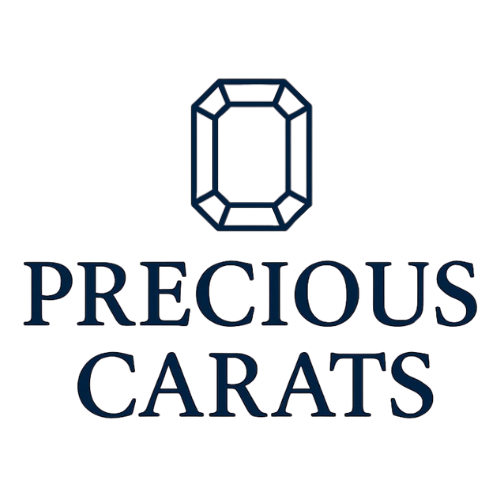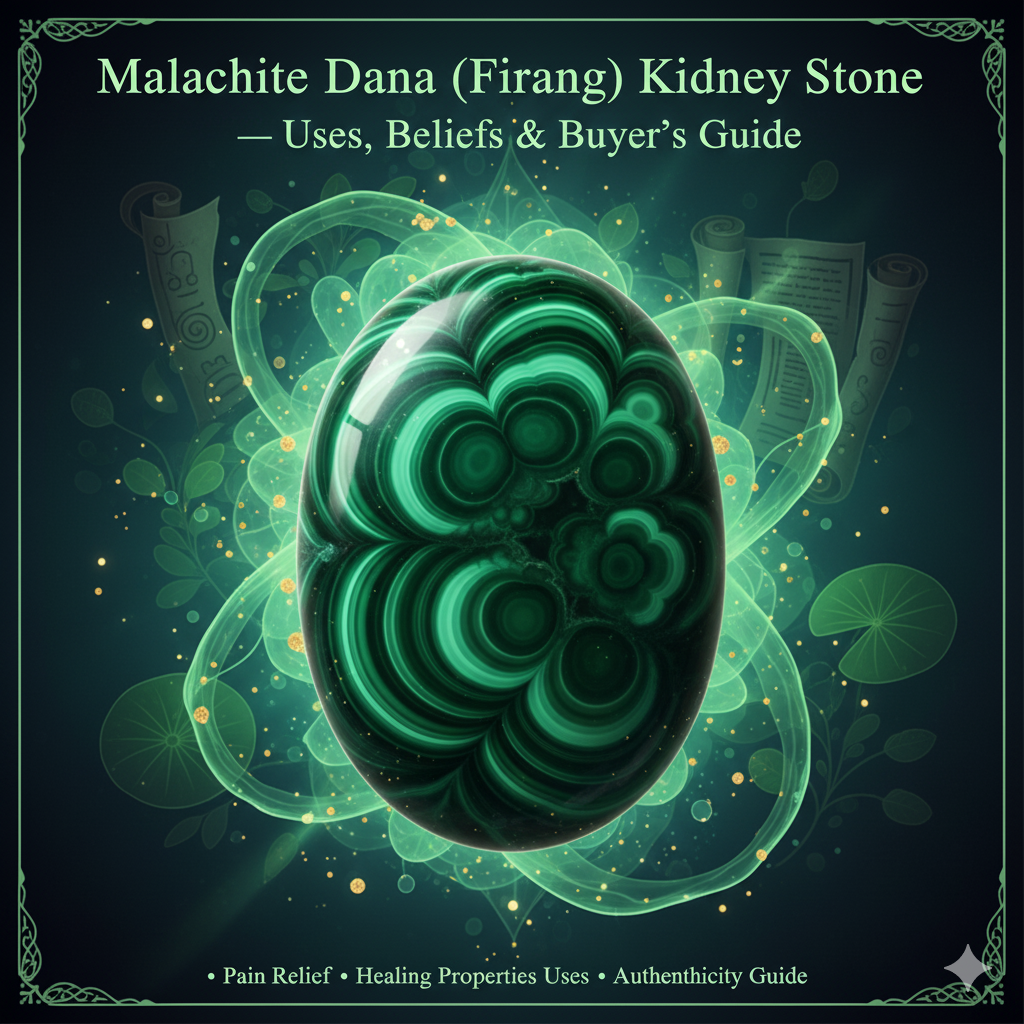Introduction
Malachite Dana, also called Firang Dana in local bazaars, is popularly known as the ‘Kidney Stone’ in many Indian markets. This green, banded gemstone carries centuries of folklore, healing claims, and cultural charm. While many believe it has properties that support kidney health, emotional detox, and spiritual balance, it is important to note that it is not an actual medical cure. Still, Malachite remains one of the most intriguing stones in the gem world — admired for its vibrant appearance, history, and mystical reputation.
Gemological Identity of Malachite Dana
Malachite is a copper carbonate mineral, instantly recognizable by its striking green bands and swirls. It has a hardness of 3.5–4 on the Mohs scale, which makes it softer than many gemstones like sapphires or rubies. This softness means it requires careful handling, especially in jewelry. Malachite is often carved into cabochons, beads, and decorative items. Natural malachite has a fibrous, layered appearance, while fakes (often glass or dyed composites) appear too uniform.
Why It’s Called a Kidney Stone
In Indian bazaars, stones often pick up quirky names. Malachite Dana is popularly called ‘Kidney Stone’ because of its association with folk remedies for kidney and liver health. Traders also call it Firang Dana (foreign bead) because it was historically imported from Russia, Congo, and other foreign sources. While people believe Malachite Dana helps flush toxins and support kidney wellness, there is no medical evidence to confirm these claims. This belief arises more from traditional healing practices and gemstone therapy than scientific validation.
History and Cultural References
Malachite has been admired since ancient times. The Egyptians used malachite as a pigment and for protective amulets. In Mughal India, malachite beads were traded across bazaars. Russian royalty adorned their palaces with entire halls of malachite — the famous Malachite Room in the Winter Palace is a prime example. European aristocrats wore malachite for protection against evil spirits. Over centuries, it came to be valued both as a decorative gem and a mystical protector.
Astrological and Healing Beliefs
Though not part of the traditional Navratnas, Malachite Dana is sometimes used in alternative astrology and healing. It is linked with Venus (Shukra) in some traditions, believed to enhance charm, beauty, and attraction. Healers also associate it with detoxifying energy — making it popular for those seeking emotional cleansing or protection from negativity.
Healing and metaphysical claims include:
– Supporting kidney and liver health (folk belief).
– Absorbing negative energy and emotional baggage.
– Enhancing creativity and intuition.
– Promoting transformation and courage.
⚠️ Disclaimer: These are traditional beliefs. Malachite is not a substitute for medical treatment, especially for kidney-related ailments.
How to Identify Genuine Malachite Dana
With rising demand, fake malachite beads are common. Here’s how to spot genuine Firang Dana:
– Natural malachite shows banded patterns and varied shades of green.
– Fake malachite (glass or plastic) often has uniform color without natural banding.
– Real malachite feels cool to touch and heavier than plastic imitations.
– Under magnification, natural malachite reveals fibrous textures, while fakes look too smooth.
Buy only from trusted sellers to avoid synthetic imitations.
Buying Guide in India
Malachite Dana is easily available in Indian markets like Jaipur, Chandni Chowk (Delhi), Charminar (Hyderabad), and other traditional gem hubs. Prices vary widely based on quality, ranging from ₹100 to ₹2,000 for beads, while larger cabochons or carvings can cost much more. Always check origin — Congo and Russia produce some of the finest malachite. Avoid dyed composites sold as natural stones.
Jewelry and Uses of Malachite Dana
Malachite Dana is most commonly strung into malas (rosaries) and bracelets. It is also used in silver jewelry as cabochons. Healers often recommend wearing it on the wrist or near the heart chakra to benefit from its protective energy. It is also used during Venus (Shukra) upayas for enhancing charm, prosperity, and attraction. In the West, malachite is equally popular in bohemian jewelry for its unique green swirls.
Cautions and Myths
Because of its nickname ‘Kidney Stone,’ many people assume Malachite Dana can literally cure kidney ailments. This is a misconception. While malachite is admired for its beauty and folk healing associations, it should never replace medical treatment. Additionally, malachite contains copper, which can be toxic if ingested. Avoid consuming malachite powders or making water elixirs. Instead, enjoy malachite as a decorative gem or spiritual aid.
The Gossip and Masala Angle
In Delhi haats and Mumbai bazaars, sellers love hyping up Malachite Dana as a ‘foreign stone that cures everything.’ Some even call it ‘Firang Kidney Stone,’ playing on both its exotic origin and healing myths. Bollywood stylists have also used malachite jewelry in fashion shoots, adding to its glamour. While half the hype is marketing, the charm of Malachite Dana firang lies in this very mix of beauty, belief, and gossip.
Conclusion
Malachite Dana, or Firang Kidney Stone, is a fascinating gem that blends folklore, healing beliefs, and sheer aesthetic appeal. From Mughal bazaars to Russian palaces, its story spans cultures and centuries. While it is loved as a stone of detox and emotional balance, remember that its medical associations are symbolic, not scientific. For kidney health, consult a doctor. For beauty, healing vibes, and spiritual charm, embrace the green swirls of Malachite Dana.
As a buyer, always check authenticity, origin, and price before purchasing. Whether you wear it for belief, fashion, or collection, Malachite Dana (Firang Stone) continues to shine as one of the most talked-about and affordable gems in the market.

